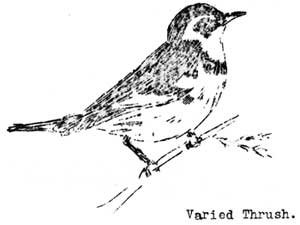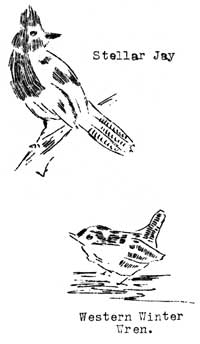
 | ||||||||
For several weeks now we have been accustomed to hear the melodious two-toned trill of the Varied Thrush. Here in Mt. Rainier National Park this means but one thing--that spring is not far off. The Varied Thrush, while it remains in the park throughout the winter as a general rule, is more evident at this season when its melodious notes ring out from the sombre, dripping coniferous forests that are slowly coming out from under winter's spell. Likewise, the near relative of this bird which is usually regarded as the herald of spring in most sections of the country, has also put in his appearance at points as high as Longmire (2700 ft.). Robins were noted at that point on February 2nd.--an early date for these birds here. Any hike along the woodland trails at the lower elevations will bring out the fact that the Kinglets are back also. They are one of the birds to return early also, and they join readily with such as the Chestnut-backed Chickadees, which remain with us through the winter, in foraging expeditions among the branches of conifers. Golden-crowned Kinglets were first noted in the vicinity of Longmire during the first week in February and one unfortunate individual that had met death in some manner was brought to the Museum on February 4th. 
The beaver dams near Longmire, in addition to providing interest relative to the animal that constructed them, also provided or developed a habitat that was to the liking of a couple of water ouzels. These interesting birds were often seen bobbing about as they rested upon small islands in the shallow pools. The Water ouzel is one of the park's permanent winter residents among the feathered fraternity.
Where do the nutcrackers disappear to in the winter? Anyone who has visited Paradise Valley in the summer time will testify to the abundance of these well known birds at that point. These crow-like "grey" birds with black wings" are abundant in the vicinity of the parking area at that point, but during the winter their ranks are thinned perceptibly--only a few being noted now and then and those are often conspicuous by their absence for many days at a time. And this in spite of the fact that large numbers of people frequent the same spot in Paradise Valley in the winter as well as in summer. 
Occasional visits into the "high country" last month were not very conducive of information regarding birds unless it was the noticeable lack of such life on "The Mountain" at this season in the upper elevations. The Oregon Chickadee was by far in greater evidence than any other; a few camp robbers and nutcrackers were noted, and although no ptarmigan were seen, their tracks were noted in the snow near the snout of the Nisqually Glacier. About the lower elevations, with the exception of the early arrivals noted at the beginning of these notes, the only birds noted during the month were juncoes, stellar jays, western winter wrens, crows, ravens and others of our permanent bird residents. But the song of the Varied Thrush, the appearance of the well known Robin and the coming of the Golden-crowned Kinglets give evidence that spring and the influx of birds to this region is close at hind. (CFB.) | ||||||
| <<< Previous | > Cover < | Next >>> |
vol12-3c.htm
01-Mar-2002